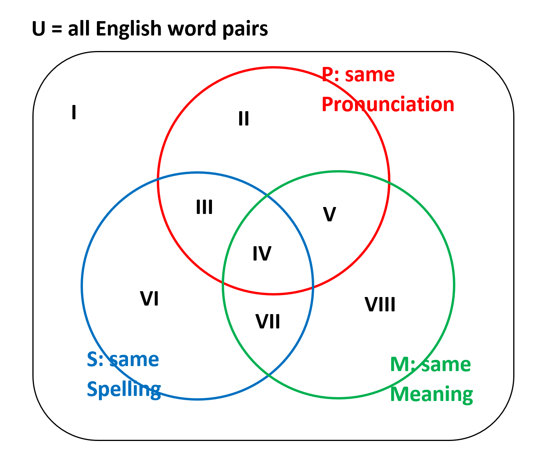The present paper aims at explaining the distribution of word pairs in the English language based on different types of similarities they may have. Every word in every language has three different aspects that do not depend on each other. These three aspects are pronunciation or phonetics, spelling or graphical representation, and meaning or semantics. Some words in the English language may be similar in one or several aspects. For instance, two words may have similar meanings but different spelling.
Thus, all words can be depicted in a Venn Diagram, which consists of three circles. Such a diagram will have eight distinguished zones, which are demonstrated in Figure 1 below. The diagram shows how all the word pairs in all variations of the English language are distributed in terms of similarities. In the chart, P represents all the word pairs that have similar pronunciation, S represents all word pairs that have a similar spelling, M represents all the word pairs that have a similar meaning, while U stands for all the word pairs. The eight zones are marked with roman numerals, where Zone I is a pair of absolutely random words, such as “pen” and “go” or “rival” and “life.” At the same time, Zone IV stands for two words, which are essentially the same, such as “stone” and “stone.” The present paper aims at describing the types of words in all the other zones.

Zone II accommodates all word pairs that have similar pronunciations but different spelling and meanings. Linguists call these words homophones, from Greek “homos” meaning “same” and “phōnḗ” meaning “voice.” Some examples of such words include “sea” and “see,” “write” and “right,” “sell” and “cell.” If words have similarities in both spelling and pronunciation but different meanings, they are called homonyms, from Greek “homos” and “onoma” (name). These word pairs fall into Zone III in the Venn diagram. Some examples of such words include “address” as a location and “address” in the meaning of “to speak to somebody” and “bat” as an animal and “bat” as a tool in baseball. Zone V includes words that have similar pronunciation and meaning while having different spelling. This zone includes such word pairs as humor and humor, center and center, program and program. This group of word pairs is called regional spelling variations.
Zone VI includes all the word pairs that have similar spelling but different meanings and pronunciations. For instance, the word “bow” as a weapon and the word “to bow” as to bend the head or upper part of the body as a sign of respect, greeting, or shame. Another example is the word “suit” as a piece of garment, and the word “to suit” as to be acceptable. These words are called homographs from Greek “homos” and gráphō (write).
Zone VII includes all the word pairs that have similar spelling and meaning but have different pronunciations. This zone includes all the words that can be pronounced differently due to an accent in a certain location. For instance, in the US, the word “Peter” will be pronounced with the sound “d” in the middle, while the British will pronounce the word with “t” in the middle. At the same time, in the word “fire,” Americans would sound the “r” sound, while the British will omit it. Such word pairs are called regional variations in pronunciation.
Zone VIII includes all the word pairs that have similar meanings but different pronunciations and spelling. These words are called synonyms, from Greek “syn” (similar) and “onoma” (name). The examples of such word pairs include “confuse” and “deceive,” “beautiful” and “pretty,” “happy” and “joyful.”
In summary, all the word pairs can be divided into eight groups on the basis of similarities. These groups include completely different words, homonyms, homophones, homographs, synonyms, spelling variations of the same word, regional variations in pronunciation, and the same words. Creating a Venn diagram is a convenient method for visualizing different types of similarities of word pairs.